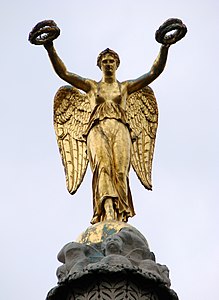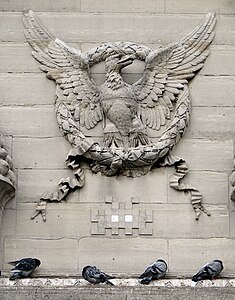Fontaine du Palmier: Difference between revisions
No edit summary |
No edit summary |
||
| Line 5: | Line 5: | ||
It was designed to provide fresh drinking water to the population of the neighborhood and to commemorate the victories of [[Napoleon Bonaparte]]. It is the largest fountain built during Napoleon's reign still in existence. |
It was designed to provide fresh drinking water to the population of the neighborhood and to commemorate the victories of [[Napoleon Bonaparte]]. It is the largest fountain built during Napoleon's reign still in existence. |
||
| ⚫ | The Fountain du Palmier was one of a series of fifteen fountains commissioned by Napoleon in 1806 to his minister of the Interior, Emmanuel Cretet. It was designed by the engineer [[François-Jean Bralle]], who was in charge of the Paris fountains and water supply during the First Empire. (See [[Fountains in Paris]]). It was finished in 1808. |
||
| ⚫ | The Fountain du Palmier was one of a series of fifteen fountains commissioned by Napoleon in 1806 to his minister of the Interior, Emmanuel Cretet. It was designed by the engineer [[François-Jean Bralle]], who was in charge of the Paris fountains and water supply during the First Empire. |
||
The column, modeled after a Roman triumphal column, takes its name from the sculpted palm leaves at the top, commemorating Napoleon's [[Egyptian Campaign]]. The bands of bronze on the column pay tribute to Napoleon's victories at the siege of [[Danzig]] (1807, Prussia), the [[Battle of Ulm]] (1805, Austria), the [[Battle of Marengo]] (1800, Italy), the [[Battle of the Pyramids]] (1798, Egypt), and the [[Battle of Lodi]] (1796,Italy). |
The column, modeled after a Roman triumphal column, takes its name from the sculpted palm leaves at the top, commemorating Napoleon's [[Egyptian Campaign]]. The bands of bronze on the column pay tribute to Napoleon's victories at the siege of [[Danzig]] (1807, Prussia), the [[Battle of Ulm]] (1805, Austria), the [[Battle of Marengo]] (1800, Italy), the [[Battle of the Pyramids]] (1798, Egypt), and the [[Battle of Lodi]] (1796,Italy). |
||
| Line 15: | Line 14: | ||
The fountain was listed as an [[Monument historique|historic monument]] of France in 1952. |
The fountain was listed as an [[Monument historique|historic monument]] of France in 1952. |
||
==Gallery== |
|||
<gallery mode=packed heights=200px> |
|||
| ⚫ | |||
| ⚫ | |||
| ⚫ | |||
| ⚫ | |||
| ⚫ | |||
==Bibliography== |
==Bibliography== |
||
| Line 22: | Line 29: | ||
== References == |
== References == |
||
{{reflist}} |
{{reflist}} |
||
<gallery> |
|||
| ⚫ | |||
| ⚫ | |||
| ⚫ | |||
| ⚫ | |||
| ⚫ | |||
[[Category:Fountains in Paris]] |
[[Category:Fountains in Paris]] |
||
[[Category:1st arrondissement of Paris]] |
[[Category:1st arrondissement of Paris]] |
||
Revision as of 01:54, 17 April 2015
This article needs additional citations for verification. (September 2011) |
The Fontaine du Palmier (1806-1808) is a monumental fountain located in the Place du Châtelet, between the Théâtre du Châtelet and the Théâtre de la Ville, in the First Arrondissement of Paris. It was designed to provide fresh drinking water to the population of the neighborhood and to commemorate the victories of Napoleon Bonaparte. It is the largest fountain built during Napoleon's reign still in existence.
The Fountain du Palmier was one of a series of fifteen fountains commissioned by Napoleon in 1806 to his minister of the Interior, Emmanuel Cretet. It was designed by the engineer François-Jean Bralle, who was in charge of the Paris fountains and water supply during the First Empire. (See Fountains in Paris). It was finished in 1808.
The column, modeled after a Roman triumphal column, takes its name from the sculpted palm leaves at the top, commemorating Napoleon's Egyptian Campaign. The bands of bronze on the column pay tribute to Napoleon's victories at the siege of Danzig (1807, Prussia), the Battle of Ulm (1805, Austria), the Battle of Marengo (1800, Italy), the Battle of the Pyramids (1798, Egypt), and the Battle of Lodi (1796,Italy).
At the top of the column is a statue of Victory made of gilded bronze, carrying the laurels of victory. People sometimes mistake the statue of the woman representing victory for a bird. The statue is the work of the sculptor Louis-Simon Boizot. The present statue is a copy; the original is in the courtyard of the Carnavalet Museum of the history of Paris.
Around the base of the column are four statues representing Vigilance, Justice, Strength and Prudence, also made by Boizot. The lower basin of the fountain, designed by architect Gabriel Davioud, was added to the fountain in 1858 during the reign of Emperor Louis Napoleon. At that time the base was also decorated with statues of Egyptian sphinxes spouting streams of water, sculpted by Henri Alfred Jacquemart.[1]
The fountain was listed as an historic monument of France in 1952.
Gallery
-
Figures of Vigilance, Justice, Strength and Prudence
-
Statue of Victory atop the Fountain
-
Sphinx at base of the Fontaine du Palmier
-
Imperial eagle on the Fontaine du Palmier
Bibliography
- Marie-Hélène Levadé et Hugues Marcouyeau, Les fontaines de Paris : l'eau pour le plaisir - Paris, 2008.
- *Paris et ses fontaines, de la Renaissance à nos jours, texts assembled by Dominque Massounie, Pauline-Prevost-Marcilhacy and Daniel Rabreau, Délegation a l'action artistique de la Ville de Paris. from the Collection Paris et son Patrimoine, directed by Beatrice de Andia. Paris, 1995.
References
- ^ "La fontaine du Palmier". paris1900.lartnouveau.com.



